For this church:    |
|
| In Memory of the Revd Richard Hardy, LL.B. Rector of Langar, Vicar of Kinoulton, and Curate of Owthorpe. He died August the 6th 1775 Aged 64. Also of Mrs Anne Hardy, Wife of Reverend Richard Hardy. She died Sept. 10, 1782, Aged 64. |
A small marble tablet on the north wall is inscribed:
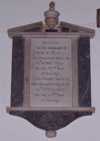
SACRED  Also Sarah his Wife, |
North aisle
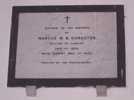 There is a tablet to the Rev W. B. Osmaston, rector of Langar from 1915-26, who died on 1 May 1926.
There is a tablet to the Rev W. B. Osmaston, rector of Langar from 1915-26, who died on 1 May 1926.
North Transept
This part of the church was left untouched when Thomas Butler carried out major restoration in 1860, although his initials can be seen on the capital of the pillar on the left. It contains monuments to three generations of the Chaworth family, of nearby Wiverton Hall.
Monuments to the Chaworth Family
George Chaworth
 Tablet inscription Tablet inscription |
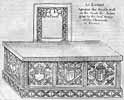 Engraving of the Engraving of the monument (1676) |
Fixed against the north wall is a panelled stone altar-like structure, at the back of which is a tablet, of which the inscription is in gold letters on a black background:
| By this Tomb-side, lieth George Chaworth, late Lord, of Wereton and Anesley, Son and Heir of Thomas Chaworth, of Cropull-Butler, and Father by Katherine his first Wife, of John Chaworth, Knight, and George Chaworth, Squyre, and of Anne, Dorithy, Elizabeth and Katherine; and Father, by Elizabeth his second Wife, of Thomas, Chaworth, only; which George, the Father; Died 22nd September Anno 1521; and the said Katherine, his first wife, buried under this tomb - she died 12th of October 1517; for those Souls of your Charitie, say a Pater Noster and Ave Marie. |
Sir John Chaworth and his wife Mary
 Effigies of John and Effigies of John and Mary Chaworth |
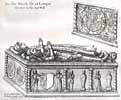 Engraving of the Engraving of the monument (1676) |
The second monument, of alabaster, commemorates Sir John Chaworth and his second wife, Mary, daughter of Sir William Paston. Above lie the effigies of Sir John and Lady Chaworth, the former wearing a suit of armour, a small ruff round his head and neck, and a large double chain over his shoulders to which is attached a cross pate. His hair is curiously arranged, and he wears a moustache and long beard. His hands, adorned with a number of rings, are raised in prayer, his feet touch a couchant lion, and his head rests upon a helmet with crest - a dragon’s head, couped, or, theron three bars gules, for Basset of Weldon.
The head of his wife reposes upon two tasselled cushions of elaborate workmanship, her upraised hands having also a profusion of rings. A chain, with cross pate attached, thrice encircles the small ruff round her neck. A long chain which passes round her waist terminates in a pomander hanging near the feet. Round the margin of the tomb, beneath which are eleven small shields each bearing the capital P, is the following inscription:
| Sic Facet Johnes Chaworthe miles filius georgij Chaworthe armigeri qui obijt aput wiverton 3 die septembris ano dni 1558 et habuit prius nupta toalero rodn’ militi et duas uxores uz elizabeth fuit soror tvilli Compton militis et obijt sine exitu et mariam que fuit filia tvilli paston militis et labuerunt quatuordecem liberos et obijt ano et mense supradicto et una cum eo hic sepilitur cui societ ut tumulus societ obsecro etiam sic mors quod nos potuit dare bita dabit……. |
The north side of the monument, divided into three compartments, contains upright effigies of five daughters in caps and long gowns with pendent pomanders in front, and of four infants in their chrisoms.
Sir George Chaworth
 Sir George Chaworth's Sir George Chaworth'smonument |
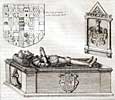 Engraving of the Engraving of themonument (1676) |
The third monument, also of alabaster, is that of Sir George Chaworth, son and heir of Sir John, who died 4 March 1589. Above lies the effigy of Sir George, in armour, reposing upon a mattress ornamented with a bold pattern worked in relief and rolled at the head and feet.
There is no inscription, the upper edge of the monument being ornamented with conventional carving. Thoroton, however gives the following inscription as appearing “upon the wall”:
“Here lyeth buried Sir George Chaworth, Knight, son and heir of Sir John Chaworth, Knight, the said Sir George having issue Elizabeth, his sole daughter and heir, not five years old when he died, which was 4 Martii, an.1589 by Anne his wife, the daughter of Sir William Paston, Knight, surviving him; she was next married to Sir Nicholas Straunge, Knight; and afterwards to Sir Anthony Cope, Knight.”
Thoroton also states:
“Upon the side of this Tomb is writ, Henr. Chaworth, Ar. Fil. & haer. Georgii Chaworth, Ar. Fratris suprascripti Johannis, ac proximus haeres masculus supra nominati Georgii Chaworth, militis, posuit.”
Fixed on the wall above the feet of the effigy is an alabaster tablet with pillars supported on brackets on either side, enclosing a shield bearing the arms (quarterly of twelve as on the above impaled shield) of Chaworth, surmounted by a helmet with mantling, and crest - A tower argent, on the battlements of a plume of five feathers argent, to the left of which is the initial P.
Suspended from a bracket over this tablet is a piece of “funeral armour”, consisting of an armet, surmounted by the crest of Chaworth, as described above. Thoroton records that a sword also existed, but this is now missing.
Henry Charlton Chaworth Musters
A diamond-shaped marble tablet on the east wall is inscribed:
| To the beloved memory of Henry Charlton Chaworth Musters Lieutenant 3rd King’s Own Hussars youngest son of John Chaworth Musters of Annesley and Wiverton in this County and Lina his wife. He was born October 19th 1871 and died while on active service February 24th 1897 aged 25, after distinguishing himself during the Niger Soudan campaign of liberation and the capture of Bida. He lies buried at Burutu West Africa but lives in the hearts of those he left behind. |
Family Vault
Beneath the North Transept is a vault, containing an upright lead coffin. This has been damaged, presumably by raiders. The occupant is unknown but is probably one of the Chaworth family.
South Aisle
 The
Howe family vault occupies a considerable area at the eastern end of the south
aisle, and forms a raised platform in this corner of the church, accessed by
a stone staircase.
The
Howe family vault occupies a considerable area at the eastern end of the south
aisle, and forms a raised platform in this corner of the church, accessed by
a stone staircase.
South Transept
Thomas and Philadelphia, Lord and Lady Scroope
 View of monument View of monumentfrom the north |
 The effigies of The effigies ofLord and Lady Scroope |
 Effigy of Effigy of Emanuel Scroope |
 View of monument View of monument from the west |
 Engraving of the Engraving of themonument (1676) |
In the south transept is a stately tomb of black and white marble, one of the finest examples of its kind and period, supporting the exquisitely carved effigies of Thomas, Lord Scroope of Bolton, K.G., and of Philadelphia his wife, the daughter of Henry Carey, Lord Hundson; above there is a marble canopy or cover composed of triple composite columns of black marble (some of which are badly fractured) placed at angles of the tomb, and bearing an entablature and a flat table cover, which cover is adorned with the armorial bearings, crest, and motto of Lord Scroope in the centre, and with others upon shields at the angles between the family supporters.Lord Scroope is represented in armour, with the collar, mantle, and - what was very rare - the cap of the Order of the Garter, and a full ruff, with his head resting upon two tasselled cushions, and his hands joined and raised in prayer. He wears a stilleto beard and small moustache. Lady Scroope is presented in a full flowing mantle and a ruff, and with her hair turned back from her face according to the fashion prevalent in her time. At the feet of the two principal effigies, which rest against their respective crests (that of Lady Scroope being a swan with elevated wings), is another, of the only son of Lord and Lady Scroope, Emanuel, created Earl of Sunderland in 1627. He is represented kneeling on a tasselled cushion, with an open book in his right hand, his forefinger between the leaves, and his left hand resting upon the hilt of his sword. This figure is out of proportion, being much smaller than the two main figures.
On the north side, in two panels, side by side, is this inscription:
|
|
The two corresponding panels on the south side are inscribed:
|
|
The panel on the east side is inscribed:
EMMANVEL SCROOPE SON & |
The corresponding panel at the west end is blank.
Concerning this transept and monument, Dr Thoroton states:
“In the South Cross-Ile is a fair Tomb for Thomas Lord Scrope and his Lady, wheron lie their Effigies at full length; at the feet whereof is the figure of their son Emanuel kneeling in much less proportion; the Top or Canopy of the Tomb (whereon are their Arms with quarterings) is supported by tall Pillars of Black marble well polished. In the windows on that side is Arg. A Saltier engrailed Gules, Tiptoft. And in some places Azure a Bend Or, Scope, quartering the former”.
Two Carved Busts
Bust to Scroope Lord Howe the Elder
In the south-east angle of this transept a well executed portrait bust is supported on an elegant marble pedestal inscribed in twenty-two lines of varying length:
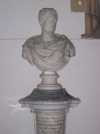
| Erected to the Memory of the Rt Honble SCROOPE LORD Visct HOWE, who Departed this Life the 16th Day of January 1712, Aged 64 Years. At the Revolution in the Year 1688, he remarkably distinguished himself in the Preservation of the Religion, & Liberties, of his Country when Popery & Arbitrary Power threaten’d the Subversion of both. He married, ANNE the Daughter of IOHN EARL of RUTLAND, by whom he had Issue, one Son, who died young and two Daughters. Also IULIANA the Daughter of WILLIAM LORD ALLINGTON by whom he left Issue, two Sons and three Daughters |
Bust to Scroope Lord Howe the Younger
In the south-west angle is a corresponding pedestal also bearing a marble portrait bust. The pedestal is inscribed in twenty-three lines:
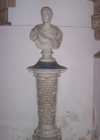
| This Monument was Erected, by His Sorrowful Mother to ye Memory of Rt Honble SCROOPE Lord Visct HOWE: who in the year 1732, was by his Majesty KING GEORGE the 11d; appointed GOVENOUR of BARBADOS. Being adorned with all those great and amiablle Qualification which Render a Man truly Noble, by His Conduct in that High Station He gained the Respect and Esteem that was Justly due to a Generous, Wise, Impartial & Disinterested GOVERNOUR. He departed this Life there March 28th 1734 in the 35th Year of His Age. He was Married 1719 to Mademoisell Keilmansegge, and Left Issue by Her, Four Sons & four Daughters. |
Tablet to Admiral Earl Howe
Fixed on the wall of the blocked-up archway on the west side of this transept is an oblong marble tablet to Admiral Earl Howe:
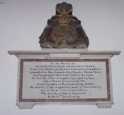
| To the Memory of RICHARD HOWE, EARL and VISCOUNT HOWE, VISCOUNT HOWE and BARON CLENAWLEY, in Ireland; Admiral of the Fleet, General of His Majesty’s Marine Forces And Knight of the Most Noble Order of the Garter: He died the 5th Day of August 1799; Aged 73 Years. Also of MARY JULIANA HOWE, Second Daughter of RICHARD EARL HOWE; She died the 9th day of April 1800; in the 35th Year of her age. And of MARY COUNTESS HOWE, Who died the 9th Day of August 1800; In the 67th Year of her Age. |
Tablet to Anne Mordaunt
An oblong brass plate, let into a large floorstone on the north side of the Scrope monument, is inscribed:
| The Honble Anne Mordaunt Daughter of Scroop Ld Viscount Howe Wife of Charles Mordaunt Esqr Died 21st Augst: 1753 Aged 42 Years. |
Fixed in the north-east angle, near to, is an upright brass plate, 16¼ inches high by 12¾ inches wide, with embossed margins, evidently a coffin plate, which bears a somewhat similar inscription in tasteful script lettering.
Worn Memorial Stones on the Floor
Between the Scrope monument and the south wall are three large floorstones, apparently those mentioned by Stretton. The northernmost, of stone, has the remains of a cross and an illegible inscription. The centre one, of alabaster, has the remains of an incised figure the upper part of which is entirely worn away, but part of the tabernacle work over the head and the lower part of the dress, which hangs in folds, and the feet, remain. The legible portion of the inscription reads:
…..Thomas…….Decimo Die Junij Anno domini MCCCCC xxxvii….
The southernmost slab, of stone, much worn, has the remains of a cross, and an inscription of which the following is legible:
…..Hic jacet………….obiit ibo die mensis aprilis ao.dni.mo.cccco…..cui aie.ppiciet.de.am..”
A small defaced slab, near to, has at the foot the word VIRGINIS.






